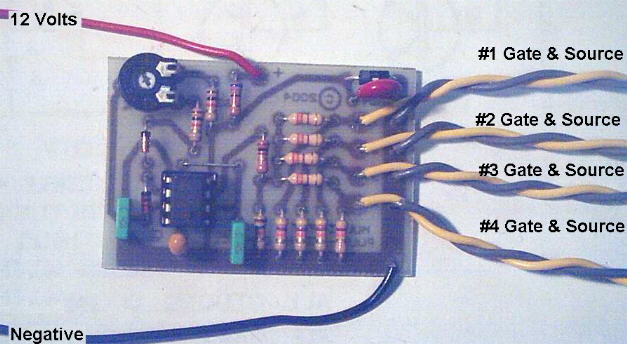"A Pulse Width Modulation Control"
Newley Revised "August 31 2003"
Higher Power Circuit Revised "Mar 31 2008"
This particular circuit was built for 12 volt DC operation, but can be operated at other voltages assuming you don't exceed the 555 operating supply voltage.
A New Design: at the bottom of this page, will allow for MUCH Higher Power. As well it is easily modified for Higher voltage supplies! I have not done a design for "P-Channel" Mos-Fet's in This Higher Power Design, as I don't consider it as practical for these VERY HIGH CURRENTS.
Changes to the Potentiometer value as well as the .01 cap on pin 2 of the 555 can be made to change the operating frequency. A lower value capacitor will result in a higher frequency. However I don't suggest a much Lower value Potentiometer, Higher is OK! The duty cycle range is determines by the value of the pot plus the two 1k current limiting resistors, one at each end of the pot.
All of these circuits are relatively stable in Frequency as the Pulse width changes!
I used a RFP50N06 N-Channel Mos-Fet, but depending on your need, other types may be used instead.
I have provided for a heatsink on the circuit boards. It may or May Not be needed for your particular application. Definately not when drawing only one or two amps. At very high currents, it may be advisable to mount the Mos-fet off board and connected to the board with reasonably short wires. (under 8 inches)
In the event of running high current motors, over 5 amps (?), there might be large spikes that can distroy the 555. Replacing the 1N4005 diodes with Schottkey diodes or 15 volt Movistors will definately help.
For Real High Currents, it is possible to Parallel two or more Fets. But there should be independent Gate resistors, as well as a 0.05 to 0.1 ohm Source Resistor on each Fet. This helps distribute the current evenly between all the Fets.
NEW Due to a large number of requests, I have added the imformation on the schematic for an RFP30P06 P-Channel Mos-Fet. This allows for operation of devices where you can't easly remove the ground from them. Other simular Mos-fets should also work
I didn't include a parts list, as I feel it is too simple to bother with.
Etched and drilled PCB's are available,
A Picture of the first Proto-Type I made and tested
Note this proto doesn't have the 1N4005 diodes.
Also the Trimpot can be a regular pot, wired off-board.
HIGHER POWER, Up to "4 Paralleled" Mos-Fets.
This Circuit as Pictured was able to push Over 30 Amps into this motor, but even with a battery charger, it was Sucking that Battery down. This motor is The Biggest Load I have available for testing this circuit and I only used "three" Mos-Fets on this test.

All Imformation in this Article is "Copyright protected".
Chemelec
*Copyright © 2003 and 2004*

